When a player chooses a play style in a game, he is presented with a multitude of options. A “fighter” can use many weapons, parry, dodge, and use potions or magic scrolls. A “thief” can usually sneak around, hide in shadows, use sound cues, distract the enemy, turn off lights or use gadgets. Even in non-RPGs, such as a racing game, one can change their car, tweak the engine, ram into enemies or drive peacefully. And he can do it all dynamically, at any point in the game, constantly adjust and re-adjusting his strategy.
But a “conversationalist” – what can he do besides merely picking from one of the few predefined responses?
There are traditionally two approaches to doing conversation in games:
- The CRPG style of “choose your response”
- The Mass Effect / Alpha Protocol / Dragon Age system of “choose your attitude.”
While they work well as a narrative tool, they are both fairly limited as a gameplay mechanic. There is no room for clever thinking, experimentation, trying new “strategies” or even fixing errors in judgement. The infrequent stat-modifier on level-up is oft not enough to provide dynamic change. If we wanted to make a game one can played purely via “Diplomatic Style” (not merely “sneaking behind enemies”), both of these traditional methods fail. With the first approach, just look at Planescape Torment as an example; if you allow your player to beat the game via clever conversation skills alone, you wouldn’t have a game, but a semi-interactive novel. And the second approach is potentially even more limiting, resulting in a glorified “choose your own adventure” or a semi-interactive cutscene.
Effectively, what I am asking is – how can we “gameify” the conversation system to make a game that relies squarely on it more engaging and interesting, without turning conversations purely into some silly minigame?
Sure, good writing will keep the player hooked; but at the end of the day, this is a game, not a book. And form that, some of the below ideas were born.
The Appearance Wheel
While this is similar to the “ring of charisma +2” approach, it is a bit more sophisticated than that. Basically, the available responses in a conversation are based on the player’s current level in three to four “appearance categories”:
- Intimidation / Threatening
- Credibility / Intelligent
- Amiability / Friendly
- Politeness / Polite (OR: Suave / Charming?)
Contrary to first impression, these are not in any way influenced by stats. This is our appearance, how we are *perceived* by others – they are calculated based entirely on the currently equipped items! Thus, putting a nailbat in our hands will increase our intimidation level. Putting on a fancy suit and a pair of glasses might increase our (perceived) intelligence level. Or putting on the commoner clothes increases our amiability level.
Some characters may be more easily intimidated than others. Some may only share their problems if you charm them. Or we can flip it too – they may refuse to talk to you if you look like “one o’ dem smarty university peoples” or even throw you out of the office and call security if you look too threatening (which, carrying a bazooka and being wrapped in heavy kevlar armor probably would if you walked into Bank of America).
The point is: that the player can thus actively change conversation strategy by altering his appearance, rather than relying on hard-set and fairly immutable stats. And since a purely diplomatic character would need not carry (m)any weapons or thieving tools, he could use all the inventory space for different sets of costumes tailored to different approaches.
The Factional Appearance System
Basically an extension of the above system, where you additionally have an “appearance category” for each faction in the game. Putting on the rebel clothes and a red armband symbolic of their struggle makes them more amiable towards you (but makes the government agents dislike you). Conversely, wearing a company shirt makes the employers of a said company more likely to share information with you.
This could be interesting for a heavily faction based game (especially when said factions are at odds with each other) where you would either face discrimination, or have to adjust your appearance to blend in with different groups (or even, disguise yourself).
The Attitude Wheel
This approach aims to mesh the traditional CRPG “choose your answer” with the modern “choose your attitude,” by basically making you do both! First, you choose your answer from the list, and then you choose your attitude. Again we have 3-4 categories:
- Aggressive
- Friendly
- Suave
- Pleading
After you pick a response, you then have to pick your attitude as a point on a triangle / square or a grid where each corner is one of the above choices. This allows you to mix them – you can be fully aggressive, or mostly aggressive with a bit of suaveness. Or mix suave and friendly approaches.
To make this even more interesting, lets add in the appearance (or even stats) to it: how far each corner of shape sticks out (i.e. to what degree “aggressive/friendly/suave” you can maximally be) depends on your appearance (or your stats if we wanted to have those). So you could “prepare” yourself ahead of conversation by putting on the right clothes, but unlike the Appearance Wheel system, if things start going badly, you can still potentially save yourself by switching your attitude.
Problems
- Cognitive Dissonance – some of the combination may not make much sense (aggressive approach with a kind reply). Maybe requires a re-thinking of how the dialog-trees are written?
- Possibilities Overload – infinite set of possibilities means it’s hard to make a good choice => most players would choose extremes or just stick to neutral?
- Difficulty in creating dialogs – no longer a simple tree, you must now plot responses based on a N-dimensional metric. But can be alleviated, see idea for editor below.
- Needs tons of dialog written – to account for many different attitudes
The Static Network
Conversations are inherently node-based, so instead of showing them one by one, why not represent them as a network of nodes the player can traverse, or even back-track? A player sees the opening node (“Heya stranger”) and a few possible responses; after picking one, the NPC’s reaction to that node is uncovered and a new list of response-nodes is shown. Moreover, each node could have a certain “requirement” or “cost” needed to actually select it, represented via a “techniques” or “approaches” such as:
- Assert (Assertive)
- Inquiry (Inquisitive)
- Compliment (Charming)
- Threaten (Threatening)
- Insult (Insulting)
- Convince (Trustworthy)
- etc.
A Tech becomes available when we learn the associated skill (no number – not a stat!). But it’s strength depends on your Appearance (aka. currently carried equipment). Thus, to threaten someone, a player must learn the “threat” skill, and he can boost his effectiveness by putting on a bazooka and kevlar. This way, starting out, you can only “unlock” certain parts of conversations. But as you explore the world, re-imagine yourself and learn new skills, you gradually become more versatile in conversations. Revisiting old conversations later in game can allow you to uncover new information and talk about new topics. In a way, just like open-world games enable world backtracking, this enables conversation backtracking as well (which is realistic – you do ask people “remember when you said xyz…?”)!
Of course, certain key questions posed by an NPC could, when a player selects an answer-node, automatically break the connection to all the other not selected answers, meaning a re-starting player can no longer try the different answers. Or, they could break the connection to the selected answer, meaning the player can no longer track back before the current node (and if he restarts the conversation, he starts from that node, rather than root node). This means that general-purpose nodes (the typical questions like “who are you,” “what is this place,” “where can I find” etc.) can be back-tracked and changed, whereas key plot nodes (“what do you think happened?” -> “1. He killed them all!” “2. It was an unfortunate accident.” “3. A third party was involved!”) would solidify and not be changeable anymore.
SIDENOTE: Why this is better than traditional skill checks
While this is similar to simple skill / stat checks, it has a crucial difference – transparency. In traditional conversation system, the player doesn’t even know how his skills could affect the conversation (he doesn’t see “[SEDUCE] I like your hair” until his seduction skill is at appropriate level), and doesn’t understand what it would take to actually use a given response (an answer “[SKILLCHECK: Charisma] Gimme money!” tells the player charisma affects it, but not how it affects it). Lastly, by choosing one response in a skill-check based list, the player usually no longer has the ability to go back and ask about something else, or try a different approach.
A network amends those issues. First, the player can see all his responses (but only up to the reached depth) with associated costs (“oh I need Threat at level 2 and Blackmail to choose that response”). Second, the player can either walk-back the tree, or restart from root node at any point and choose different questions or comments. What this effectively means is that, unlike traditional conversation, when a player stumbles upon a response he cannot use, he can instantly make a mental note that this response exists and later in the game, when his skills improve or he has better disguises, he can come back and re-trace his conversation back to that node, opening new pathways.
The Dynamic Network
This is the same as the above approach, BUT the available approaches / techniques are dynamic. That is, a player gets a certain set of techniques at the beginning of a conversation (again, which depends on skill, how many depends on appearance), and the “cost” of a selected node is subtracted from his current techniques each time he makes a choice. Thus, as player makes conversation choices, he “spends” his techniques. But some nodes can give him new techniques as well (for each NPC answers there’s new questions a player can ask, or getting an NPC to admit an incriminating fact could give the player extra leverage!), some nodes could unexpectedly take them away (piss off an NPC and your compliments wont work anymore). And to make things more complex, reaching some nodes may “break off” the ties with the network, making it impossible to backtrack anymore (such as if an NPC gets annoyed or scared and may not want to talk to you about other things anymore).
But perhaps we got off on the wrong foot?
Perhaps implementing more complex conversation systems doesn’t make the conversation more engaging, but in fact cheapens it, making the inherently complex idea of human interactions just too fake and gamey. Perhaps, then, it’s not really the conversation mechanic that needs to be altered, but rather, the story and game flow that surrounds it? Just as game designers have to carefully plan ventilation shafts, mark doors as locked and give keys to some characters who can be pick-pocketed in order to create a “stealthy” gameplay, perhaps a conversation centric game, using just simple trees, needs to be design in such a way that certain conversations reveal key information, which can then be used and built upon in other conversation (perhaps with combination of some “appearance,” or collecting special items we may need, as we can learn from yet other dialogs). All this akin to traditional adventure games, or what Rockstar’s L.A. Noir is getting at?
Theoretical Example:
As an example, imagine good old JC Dentont from Deus Ex trying to break into VersaLife. Now the game already covers the “stealthy” and “guns blazing” approach well. What if we wanted to use a conversationalist approach? Maybe we could have JC enter the building and be denied access by the receptionist. Exploring around the surrounding park area, he stumbles upon a worker on his lunch break and finds out about an ongoing “investor presentation.” He goes back to the receptionist only to learn that a special pass is required for the presentation. Exploring on, he reaches the “relaxation center” of the facility, equipped with a cafeteria and even a bar. He manages to chat up a disgruntled businessman there who left the presentation early. With enough persuasion, and perhaps easing things up with a few drinks (hello “The Witcher”!) or even a small bribe, he manages to convince the guy to give him his pass. Now just a short trip to the nearest clothes store to purchase a tux. With the pass in hand and a convincing disguise, he manages to make his way into the restricted area of the facility. Now, to get access to the laboratory floors…
To Infinity and Beyond…
So these are just some of the ideas I’ve been pondering recently. I am considering making some simple prototypes (in JavaScript or Flash) to see how they flow. But before that, I open the floor to you guys…
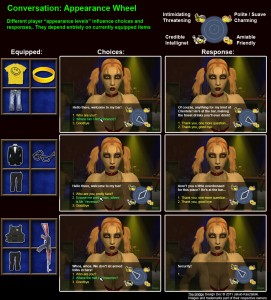
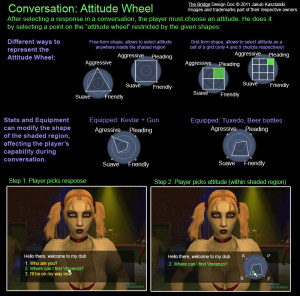
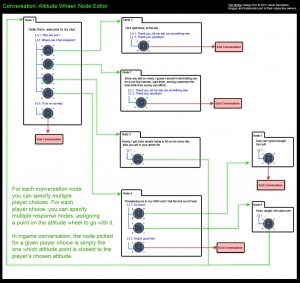
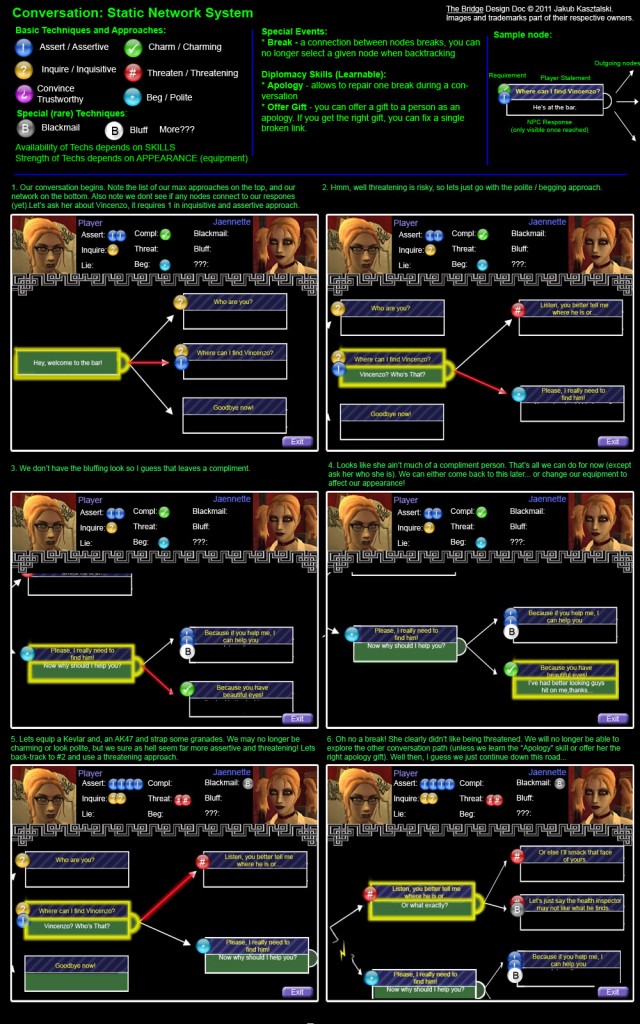
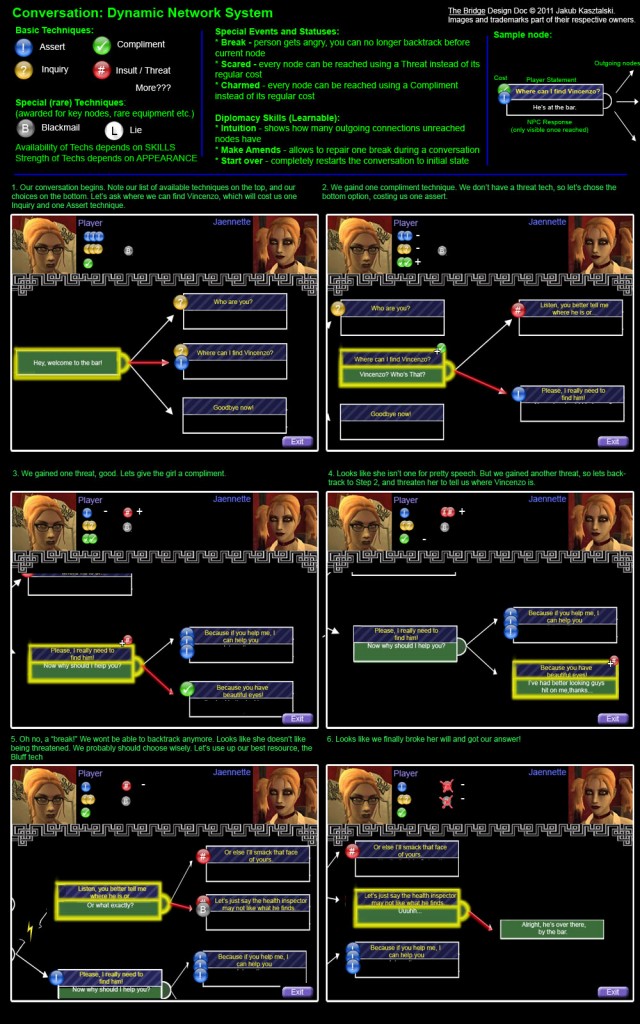
I know this if off topic but I’m looking into starting my own weblog and was wondering what all is needed to get setup? I’m assuming having a blog like yours would cost a pretty penny? I’m not very web smart so I’m not 100% positive. Any suggestions or advice would be greatly appreciated. Cheers
Hey,
You can get a simple blog running for free using sites like Blogger or WordPress. Tho, these give you limited functionality and no unique domain name (like koobazaur.com), so if you want full control you’d want a domain name (which is $10/year) and webspace (I pay around $6/month with HostMonster). After that, there’s some nifty free frameworks for getting a basic blog up and running with minimal technical knowledge, such as WordPress.
But if you want a unique domain and full control but don’t want to deal with technicalities you can always hire a professional Web Designer to make the site for you, with the prices usually starting around $400 for a 5-10 page site or blog. If you are interested I could actually take care of that, as I freelance as a web designer and developer, just check out my professional portfolio and shoot me a message!
– Jakub
+1 ))
Thank you, I’ve been looking for information on this subject forever and this particular blog is the best I have seen thus far.